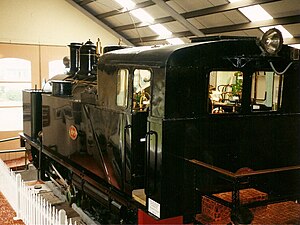NZR H Class H199 Mount Cenis
| NZR H199 Mount Cenis | |||||||||||||||||||||||||||||||
|---|---|---|---|---|---|---|---|---|---|---|---|---|---|---|---|---|---|---|---|---|---|---|---|---|---|---|---|---|---|---|---|
 H199 in the Fell Engine Museum | |||||||||||||||||||||||||||||||
| |||||||||||||||||||||||||||||||
| |||||||||||||||||||||||||||||||
| |||||||||||||||||||||||||||||||
| |||||||||||||||||||||||||||||||
NZR H199 Mount Cenis is a preserved NZR H class 0-4-2T steam locomotive. It is the only surviving rack locomotive in New Zealand and the only surviving steam locomotive to use the fell rack system in the world. The locomotive is preserved at the Fell Engine Museum in Featherston.
History and service
[edit]H199 was built in 1875 as the first of four Avonside built locomotives made for the at the time under construction Rimutaka Incline. H199 along with the other three were designated as the H class and introduced to the line in 1877 due to construction delays and issues and were later joined by two Neilson built locomotives in 1886. All members of the H class were named after mountains, with H199 being Mount Cenis after the mountain that had the first fell rack railway. After the opening of the Rimutaka Tunnel in 1955 H199, along with the five other members of the H class was withdrawn and retired in 1956 after the closure of the Rimutaka Incline.[1]
Preservation
[edit]
H199 was donated to Featherston three years later in 1958. It was placed in a park at Clifford Square where it remained part of a children's playground until 1981 when the newly formed Friends of the Fell Society moved it for static restoration due to deterioration. Three years later in 1984, the Fell Engine Museum was constructed to house H199 adjacent to the playground. The locomotive's restoration was completed in 1989 and was later joined by a fell brake van in 1997. Although on static display, H199 is mounted on rollers powered by electric motors to allow people to see how its moving parts work.[2]
References
[edit]Citations
[edit]- ^ Palmer & Stewart 1965, p. 37.
- ^ Lea 2000, p. 3.
Bibliography
[edit]- Lea, C.C. (2000). Featherston's Fell Locomotive Museum. Southern Press. ISBN 0-908616-13-9.
- Palmer, A. N.; Stewart, W. W. (1965). Cavalcade of New Zealand Locomotives. Wellington: A H. & A W. Reed. ISBN 978-0-207-94500-7.
- Stewart, W. W. (1974). When Steam was King. Wellington: A. H. & A. W. Reed Ltd. ISBN 978-0-589-00382-1.
